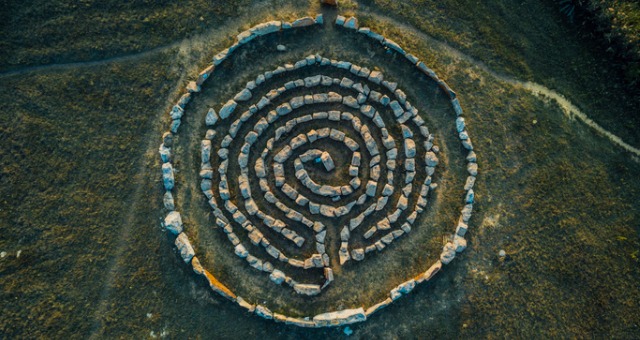What is a labyrinth?
A labyrinth is an ancient archetype with a singular meandering path that leads from an outer edge to a center. Unlike a maze, which is designed to puzzle or confuse, a labyrinth has one path in and one path out. For 4,000 years or more, the labyrinth has been used as a practice that incorporates walking, silence, and meditation among other things. Labyrinths are found in every culture and on nearly every continent. Increasingly, labyrinths can be found on university campuses and can be built from a variety of materials. Labyrinths can also be permanent or portable.
How can the labyrinth serve students?
Because labyrinths can foster a sense of well-being and inner calmness, they serve as wonderful tools in assisting students to find quiet, foster peace, and to reduce stress. During the last two decades, research in the use of the labyrinth supports its effectiveness as a way to establish calmness, reduce anxiety, and heighten creativity (Danielson, 2004; Rhodes, 2011; Devito & Dunlap, 2012), as well as bring mindful practices to students and faculty (Bright & Pokorny, 2012). Students who were recently introduced to the labyrinth for the first time on our campus had this to say:
- “The labyrinth experience was the first time I got to participate and learn about it. I felt like this really helped me pick out my larger struggle that day and get rid of it. The path to the middle and back out had so much meaning to me. I loved being barefoot and I loved burning the bad things afterwards. These little details pull the whole thing together and make me feel safe and like I can let go.” Olivia
- “My experience with the labyrinth allowed me to take a moment to escape from my reality. It was a great way to get the day started!” Jazmine
- “I want to start out by saying I loved the labyrinth experience. It was the peace I needed after this tough semester. Though I’m not much of a spiritual person, I felt at peace with the prolonged moment of silence. It’s hard to find moments like that nowadays.” Mariah
Where can I find a labyrinth?
A simple search on the World Wide Labyrinth Locator (https://labyrinthlocator.com/) will identify by city, state, and type (school, garden, hospital, etc.) where each registered labyrinth is located. A brief search revealed that 355 labyrinths are located in educational settings in the United States, and of those, many are found on college campuses. According to editors Jan Sellars and Brian Moss in Learning with the Labyrinth: Creating Reflective Space in Higher Education (2016), the earliest known example of a labyrinth built in a university context was in 1972 at Stevenson College-University of California, Santa Cruz. Since then, increased interest has led to numerous others being built.
For those who do not have access to a nearby labyrinth, there is a free app, Labyrinth Journey (https://labyrinthjourney.app/) that allows the user to “walk” with their fingers. By downloading this app, anyone can do a finger walk at any time simply by following the pattern into the center and out again.
Why the labyrinth now?
With the lingering pandemic and the ever-changing demands and challenges brought about by our students’ chosen fields of study, it is imperative that we equip them with tools that can help them reduce stress, increase creativity, and help them navigate the world in which they find themselves. Although the labyrinth is not the only tool available to our students, it is yet one more time-tested way to find a sense of calmness.
Patty Kohler-Evans is a professor at the University of Central Arkansas. She is a Veriditas Trained Labyrinth Facilitator and has provided numerous professional development opportunities in the use of the labyrinth, especially in education. She teaches graduate courses in working with students who have disabilities, advises graduate candidates seeking special education certification, and co-directs the UCA Mashburn Center for Learning.
Deanna Kay Rice is an assistant professor of education at the University of Central Arkansas whose teaching focuses on student diversity, especially those with disabilities. As a teacher educator, Dr. Rice is passionate about exploring strategies that support candidate well-being.
Stefanie R. Sorbet is an assistant professor at the University of Central Arkansas. She is the K-6 program coordinator and instructs elementary classroom management courses within the Elementary, Literacy, and Special Education Department of UCA’s College of Education. Her research interests include novice teacher mentoring and sustainability, coaching administrators to support novice teachers, service-learning as field experiences, and social-emotional learning and the connectivity to positive classroom design.
References
Bright, J. & Polorny, H. (2012). Contemplative practices in higher education: Breathing heart and mindfulness into the staff and student experience. Educational Developments, 13 (4). December 22-25.
Danielson, K.J. (2004). The transformative power of the labyrinth (unpublished master’s thesis). Sonoma State University, California.
Devito, K. J. & Dunlap, J. W. (2012) Walking the labyrinth mindfully, poster presented at the Labyrinth Society Annual Gathering, Hudson, WI, October.
Rhodes, J. W. (2011). Compilation of labyrinth walk questionnaire data. The Labyrinth Society, Trumansburg, New York Available at http://labyrinthsociety.org/useful-research-resources (accessed 11/17/21)
Sellars, J & Moss, B. (2016) Learning with the labyrinth: Creating reflective space in higher education. Eds Palgrave, UK



